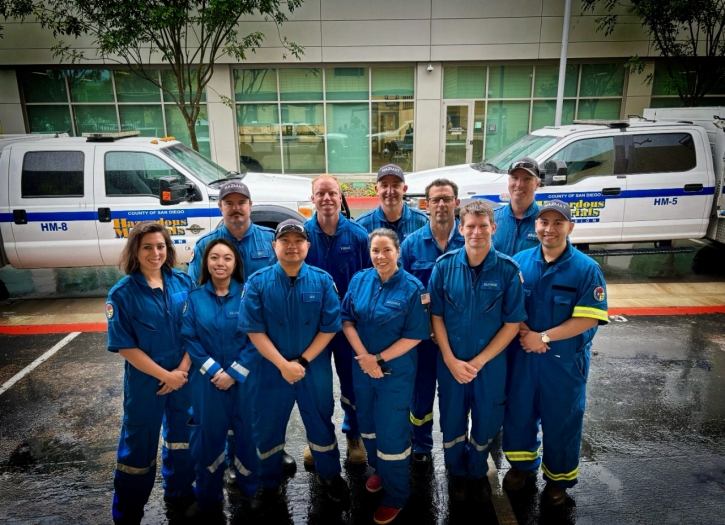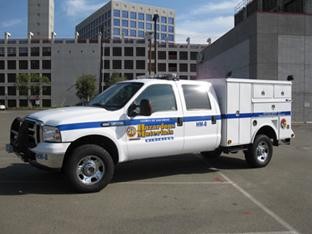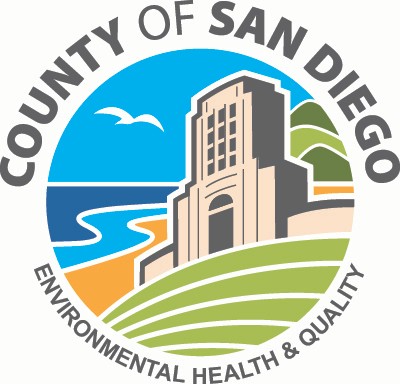HAZARDOUS INCIDENT RESPONSE TEAM (HIRT)

The San Diego County Department of Environmental Health and Quality (DEHQ) Hazardous Incident Response Team (HIRT) consists of ten California State Certified Hazardous Material Specialists. The team was founded in 1981 by the Unified Disaster Council and is funded by a Joint Powers Agreement. This team services all unincorporated San Diego County areas, 18 municipalities, two military bases, and five Indian Reservations. There are over 400 responses a year in the HIRT operational area. HIRT responds jointly with the San Diego Fire & Life Safety Services Department, Hazardous Incident Response Team to investigate and mitigate chemically related emergencies or complaints. Emergency response activities include mitigation, containment and control actions as well as hazard identification, evaluating the threat to the local populations and the environment. HIRT is also responsible for handling all after normal business hours complaints for the Department of Environmental Health and Quality. To file a complaint, please call: (858) 505-6657 or email at hmdcomplaint@sdcounty.ca.gov.

Joint Powers Agreement
The JPA is the organization that funds the HIRT. This organization is made up of representatives from unincorporated San Diego, incorporated municipalities, Military Bases and Indian Tribes. The response to all of these geographical areas will be made by combined team of HIRT and the San Diego Fire and Life Safety Services HIRT. We operate as a team!
HIRT Capabilities
HIRT – Is a CalOES Certified Type 1 Team(s) for responding to incidents involving known, unknown, and Weapons of Mass Destruction (WMD). Field detection capabilities include the ability to detect Chemical, Biological, Radiological, Nuclear and Explosive (CBRNE) hazards. San Diego is a region of diverse land use and terrain as such we have five fully equipped emergency response vehicles comprised of four-wheel drive trucks (outfitted with lift gates and heavy-duty winches for hauling hazardous waste). Each one is fully equipped for up to a level "B" response and are stocked with the equipment necessary to make a level “B” response. Reference materials, communications, detection equipment (such as combustible gas indicators, radiation detectors, and Haz-cat kits), and level “B” personal protective equipment are among the items stocked on the vehicles. Although HIRT is trained to make level “A” responses, the level "A" suits are maintained on the San Diego Fire and Life Safety Services HIRT emergency response vehicles.
Other Duties
HIRT handles all after normal business hour complaints for the Department of Environmental Health and Quality and other designated agencies within San Diego County. Typical calls that we receive are: Sewage overflows to public water ways, foodborne illness investigations, restaurant fire investigations, asbestos and lead complaints, abandoned medical waste, water sampling, substandard housing complaints, vector control complaints, and public swimming pool complaints.

Release Reporting
After the initial immediate measures have been taken to protect
human health and the environment, report the release at once to the
following agencies in accordance with State and Federal law:
1.
Call 911 for emergency assistance. This usually results in a fire
department response
2. Call California Office of Emergency
Services (Cal OES), 800-852-7550
3. Call the local CUPA (HMD) at
858-505-6657.
4. If a release exceeds the federal reportable
quantity (RQ), call the National Response Center (NRC), 800-424-8802.
Learn more detailed information on release reporting.
San Diego County Operational Area Hazardous Materials Area Plan
The San Diego County Operational Area Hazardous Materials Area Plan (HAZMAT Area Plan) describes the system currently being used within the County of San Diego for managing hazardous materials emergencies. The HAZMAT Area Plan has been prepared pursuant to Division 20 Chapter 6.95 (Section 25503) of the California Health and Safety Code and in accordance with Title 19 of the California Code of Regulations.
All Hazards Preparedness
The planning process should take an “all hazards” approach. There are many different threats or hazards. The probability that a specific hazard will impact your business or residence is hard to determine. That’s why it’s important to consider many different threats and hazards and the likelihood they will occur.
Strategies for prevention/deterrence and risk mitigation should be developed as part of the planning process. Threats or hazards that are classified as probable and those hazards that could cause injury, property damage, business disruption or environmental impact should be addressed.
In developing an all-hazards preparedness plan, potential hazards should be identified, vulnerabilities assessed, and potential impacts analyzed. The risk assessment identifies threats or hazards and opportunities for hazard prevention, deterrence, and risk mitigation. It should also identify scenarios to consider for emergency planning. For more information on all hazards preparedness please visit the links below.:
CalEPA Regulated Site Portal
Want to know more about hazardous materials related activities in your area? The CalEPA Regulated Site Portal is a website that combines data about environmentally regulated sites and facilities in California into a single, searchable database and interactive map. The portal was created to provide a more holistic view of regulated activities statewide. By combining data from a variety of state and federal databases, the portal provides an overview of regulated activities across the spectrum of environmental programs for any given location in California. These activities include hazardous materials and waste, state and federal cleanups, impacted ground and surface waters, and toxic materials.
Disaster Recovery
After disasters like wildfires and earthquakes, businesses and communities may be faced with environmental health hazards related to drinking water and food safety, power outages, chemical spills or other emergencies. The Department of Environmental Health & Quality (DEHQ) and the Hazardous Incident Response Team (HIRT) play a critical role during disasters to protect public health, including wildfires. Staff are trained in Environmental Health Training in Emergency Response (EHTER), which prepares our staff to address the environmental health impacts of disasters. For more information, please visit DEHQ Disaster Recovery Information or the Office of Emergency Services’ website on Disaster Recovery.
Household Hazardous Waste Disposal
Household hazardous waste (HHW) is the unused or leftover portion of any hazardous chemicals or materials made for household use. Any leftover household product that is labeled with DANGER, WARNING, TOXIC, CAUTION, POISON, FLAMMABLE, CORROSIVE, or REACTIVE is considered a household hazardous waste.
Visit Household Hazardous Waste to see contacts for each jurisdiction in San Diego County.
Asbestos Removal
Asbestos containing waste is classified as a hazardous waste if it is friable and equal to or greater than 1% by weight. It must be managed properly as a hazardous waste, including transport and disposal by a State registered hazardous waste hauler. Homeowners that generate asbestos wastes can contact their local household hazardous waste program for disposal options. The San Diego County Air Pollution Control District (APCD) also regulates asbestos removal, renovation, or demolition operations under other regulations. For APCD requirements please contact them at 858-586-2650 or visit APCD Asbestos Information.
Licensed Hazardous Waste Contractors
In California, unless specifically exempted, it is unlawful for any person to transport hazardous wastes unless the person holds a valid registration issued by the Department of Toxic Substances Control (DTSC). The following link is a list of State registered hazardous waste haulers operating in San Diego County, who can provide afterhours emergency response clean up service. The list also includes a list of trauma scene practitioners, laboratories for testing, industrial hygienists, and household hazardous waste contacts for each jurisdiction in San Diego County. View the list of State registered hazardous waste transporters.
Industrial Hygienists
Industrial hygienists are safety professional who provide support in the areas of hazardous materials and hazardous waste management, radiation protection, biological safety, industrial hygiene, ergonomics, safety program development, environmental audits, chemical inventorying, and safety training. For property evaluations you can check this directory of industrial hygienists.
Laboratories: Asbestos, Lead, Mold, Drinking Water, Wastewater
State Hazardous Waste Testing Labs certified by ELAP can analyze environmental samples. Be sure to verify a laboratory's “field of testing” offerings to ensure they can run the tests you require.
Trauma Practitioners
A trauma scene waste management practitioner is a person who undertakes as a commercial activity the removal of human blood, human body fluids, and other associated residues from the scene of serious human injury, illness, or death. A practitioner shall register with the California Department of Public Health and shall follow Chapter 9.5, commencing with Section 118321, of the California Health and Safety Code, of the Medical Waste Management Act. A trauma scene waste management practitioner must also provide proof of a contractual relationship with a registered transporter or the permitted medical waste facility that will receive the trauma scene waste. View the list of trauma scene practitioners.
Marijuana Extraction Dangers
In recent years the concentrating of Marijuana has become a popular activity which can be done by many methods. The main method of concern is using flammable solvents that are not contained and released to the immediate area. The flammable solvents utilized in this method are typically heavier than air and lay close to the floor. If the flammable solvents are concentrated enough, they can reach the flammable range and just need a small amount of energy to ignite. A coalition of first responders developed a first responder safety guide detailing the extreme hazards of illicit butane honey oil laboratories and the conditions that lead up to explosive result. This video demonstrates how dangerous this method can be.
Methamphetamine & Fentanyl Contaminated Properties
The goal of the Methamphetamine or Fentanyl Laboratory Clean-Up Program is to protect human health by assuring that identified properties formerly used in illegal manufacturing are properly evaluated and decontaminated and are fit for re-occupancy. This program applies to residential dwellings throughout San Diego County including single-family homes, multi-family apartments, hotel rooms, as well as mobile homes and recreational vehicles, which have been identified by law enforcement as being used for manufacturing or storing methamphetamine or fentanyl. For more information please visit the links below:
Outreach
HIRT conducts outreach such as information booths, interactive programs at schools, participation in fairs, fire open houses and more. Please visit our HMD School and Community Outreach page for more information about our programs!
Other Helpful Agencies/Links:
EPA Guidance For Lithium Ion Batteries - local options on disposal/recycling
Poison Control – contact Poison Control right away if you suspect a poisoning.
Air Pollution Control District (APCD) – for complaints about the emissions of air contaminants - including smoke, dust and odors which have the potential to cause injury, nuisance, or annoyance.
Agriculture Weights and Measures (AWM) – for complaints about pesticide use (and other topics).
Storm Water & Watershed Protection - addresses issues such as vehicles leaking fluids onto public streets, a garbage truck leaking garbage fluid onto a street, trash and debris in the street and others.
Project Clean Water Reporting Tool - Tool for other municipalities’ Watershed Protection or Storm Water program
County Code Compliance -addresses trash/furniture abandonment, abandoned vehicles, illegal businesses, and others – in the unincorporated areas of the county.
Local Municipality Code Enforcement Agencies:





